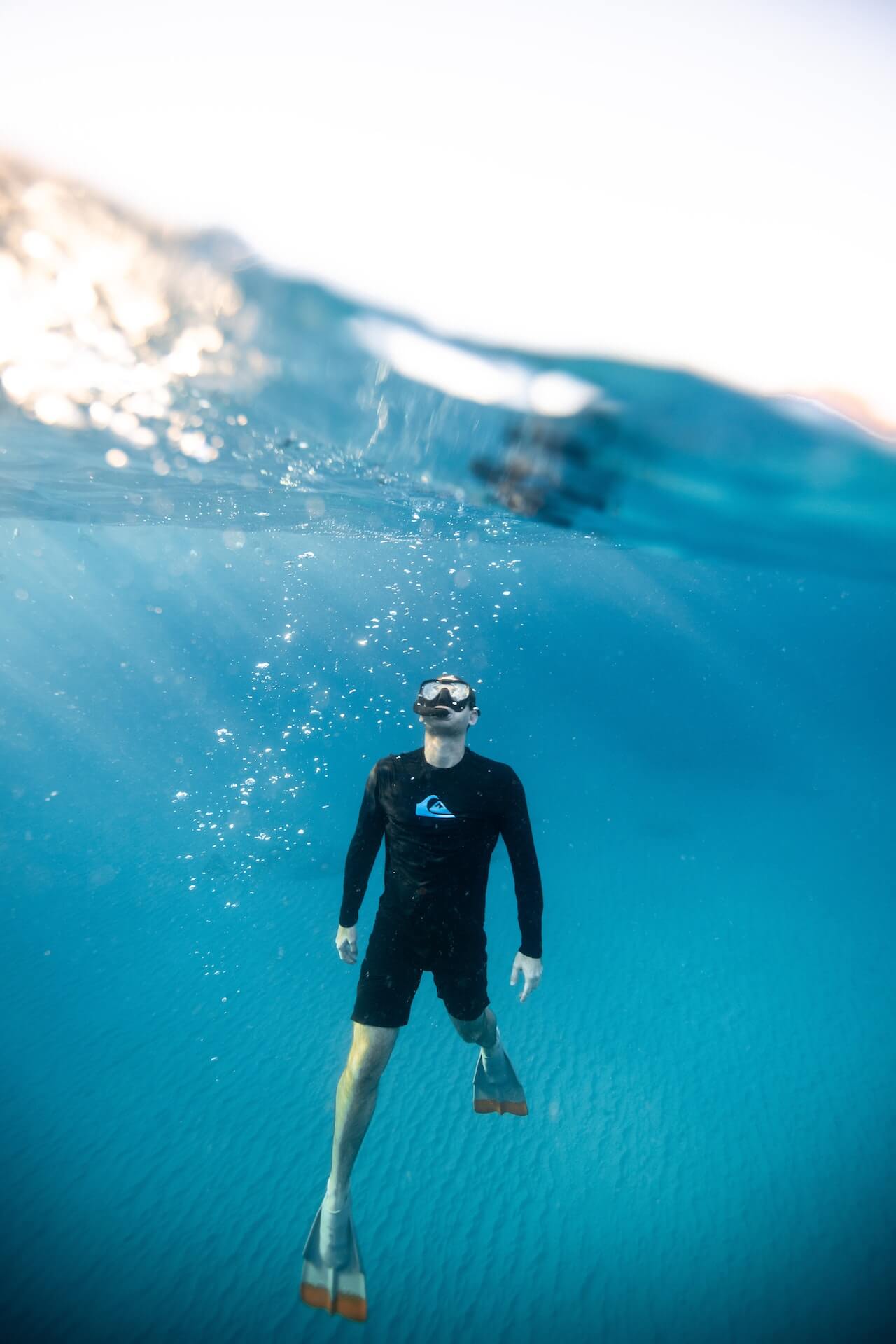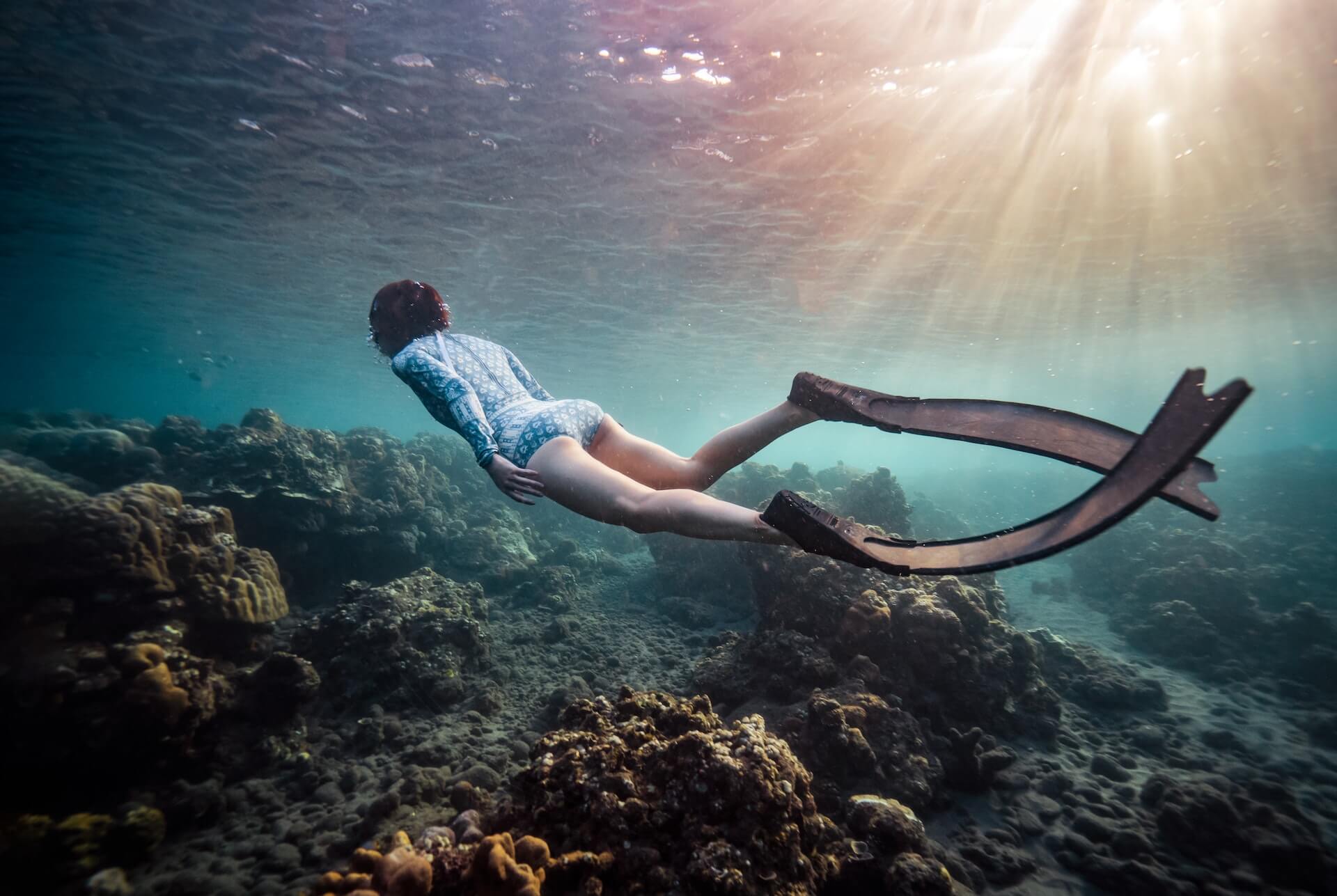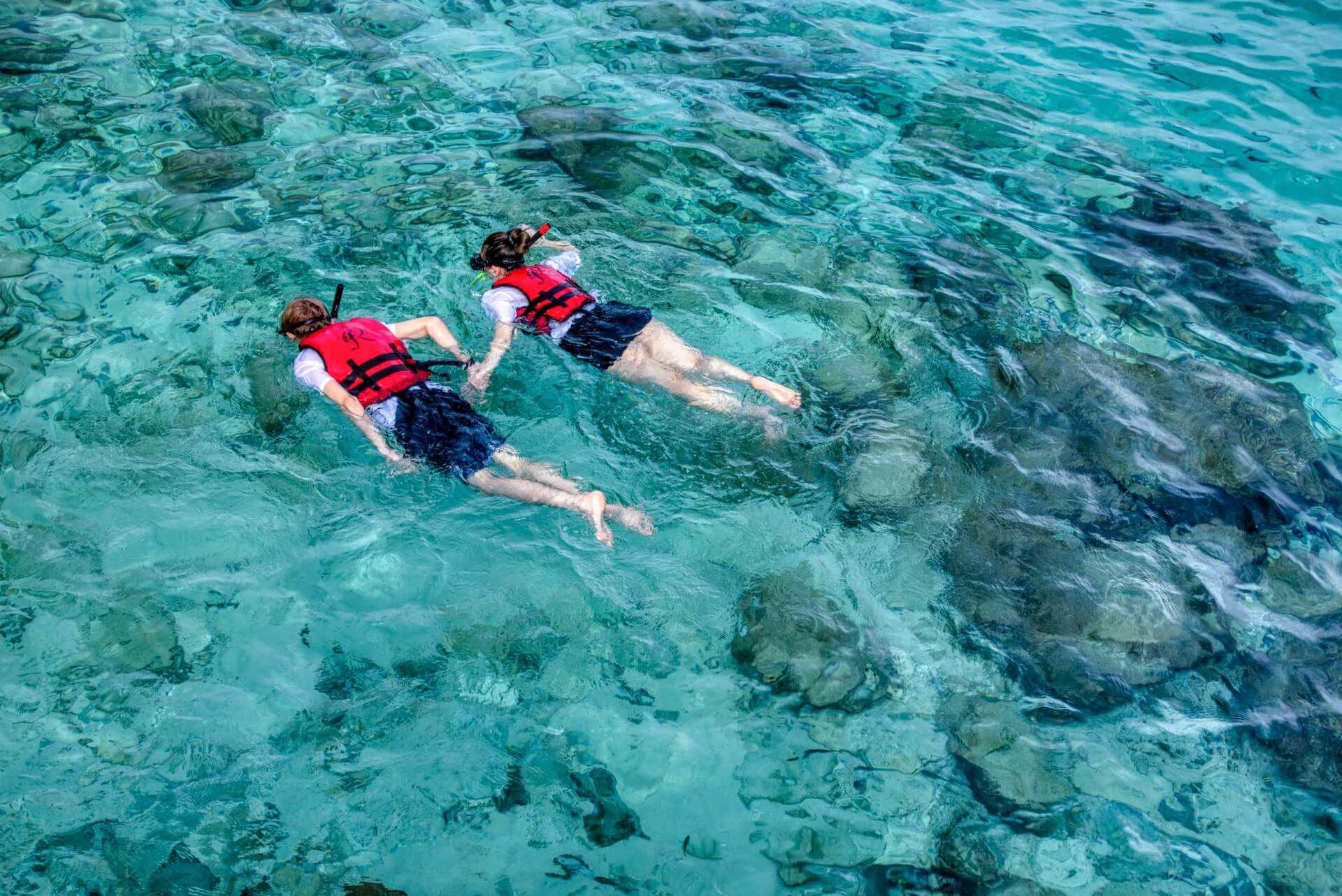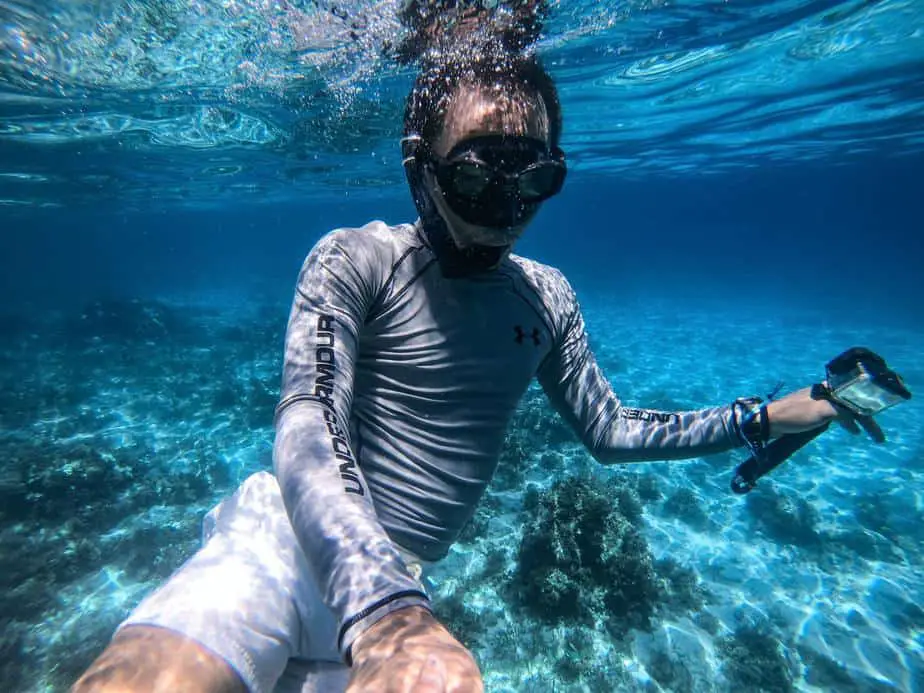Don’t you hate having to apply and reapply so much sunscreen each time you head to the beach, only to get sunburned anyways? If so, then have you considered wearing a rash guard for snorkeling?

While rash guards are not strictly needed for snorkeling, they offer much needed UV protection, rash protection, and even some protection against jellyfish stings. They can even provide some minor insulating benefits and help you save money on buying so much sunscreen. There’s lots to like about rash guards, so consider wearing one while snorkeling.
In this article, we’ll go over the pros and cons of wearing a rash guard for snorkeling to help you decide if it’s something you’d like to use.
Benefits of Wearing a Rash Guard for Snorkeling
Sun Protection
Rash guards are a snorkeler’s first line of defense against the sun’s powerful ultraviolet (UV) rays. The skin is especially vulnerable to the sun when in water, as the water can magnify the intensity of UV radiation.
Most rash guards come with a UPF (Ultraviolet Protection Factor) rating, similar to SPF in sunscreens. A UPF rating indicates how effectively the fabric blocks UV radiation. For instance, a rash guard with a UPF of 50 will allow just 1/50th of the sun’s UV radiation to reach the skin, or 2% of the original intensity.
It effectively protects the skin from potential burns and, over the long-term, reduces the risk of skin cancer. By wearing a rash guard, snorkelers can be at ease, knowing they have an added layer of protection from the sun’s harmful effects.
Save on Sunscreen

Wherever your skin is covered up by a rash guard, you do not have to worry about applying sunscreen. The reason being, the UPF 50 rating is so effective and the rash guard will not wash off, unlike sunscreen.
Thus, you only need to apply sunscreen on the areas of your body that aren’t protected by the rash guard. If you’re wearing a full rash guard, then that would be your exposed head, hands, and feet.
With so much of your body protected and much fewer exposed areas that you need to apply and reapply sunscreen to, you can drastically save on sunscreen usage.
Skin Protection
The underwater world is beautiful, but it can also be rough on the skin. Snorkelers often navigate near corals, rocks, and other marine life, all of which can cause scrapes, cuts, or rashes.
The term “rash guard” itself originates from the protection the garment offers against such abrasions. By wearing a rash guard, snorkelers reduce the risk of skin injuries, ensuring that their underwater exploration remains a pleasant experience.
Additionally, certain marine organisms, like jellyfish, can sting. A rash guard can act as a barrier, minimizing the chances of direct contact with these creatures.
Prevents Chafing

Anyone who has experienced chafing knows how uncomfortable it can be. Chafing is the skin irritation that results from prolonged rubbing, and in the context of snorkeling, it can occur due to repetitive motion like swimming or from equipment such as life jackets or fins.
Rash guards, made of soft and smooth materials, fit snugly against the skin, creating a protective layer that minimizes friction. The reduction in direct skin-to-equipment or skin-to-skin contact helps prevent the onset of chafing, ensuring that snorkelers can focus on the beauty of the underwater world instead of discomfort.
Thermal Protection
While the tropical waters where many people snorkel can be warm, prolonged immersion can lead to a drop in body temperature. Rash guards provide a thin layer of insulation, helping to maintain the snorkeler’s body warmth.
Though not as insulating as full wetsuits, rash guards are perfect for those who don’t require the thickness and warmth of a wetsuit but still seek a buffer against cooler water currents.
This added warmth can be especially beneficial for those who tend to get cold easily or for snorkeling in regions with variable water temperatures. At the very least, it’s better than nothing.
Visibility

Safety is paramount when snorkeling, and being easily visible to others is a key component of that. Many rash guards are designed in bright, easily noticeable colors or have reflective patterns. These designs not only add to the style quotient but more importantly, they make snorkelers more visible in the water.
This is especially crucial when snorkeling in areas frequented by boats or jet skis. A brightly colored rash guard can catch the attention of boat operators or fellow snorkelers, reducing the risk of accidents and ensuring a safer snorkeling experience.
Versatility
Rash guards are a versatile piece of clothing that can be worn for a variety of sports and activities besides snorkeling, such as:
- Surfing: Rash guards are commonly worn by surfers to protect their skin from the sun and surfboard wax, as well as to prevent chafing from the board.
- Swimming: Rash guards can be worn for swimming to provide an extra layer of protection against the sun’s harmful UV rays.
- Kayaking: Rash guards can be worn for kayaking to protect your skin from the sun and wind, as well as to provide an extra layer of insulation in colder water.
- Paddleboarding: Rash guards are commonly worn by paddleboarders to protect their skin from the sun and wind, as well as to prevent chafing from the board
Potential Downsides of Rash Guards
Limited Thermal Protection
Rash guards are primarily designed to protect the skin from sun and abrasion, not from cold. While they offer a thin layer of insulation, they cannot match the thermal capabilities of a wetsuit.
In environments where the water is colder or in situations where you’re likely to be submerged for extended periods, the body can lose heat rapidly. Prolonged exposure to cold water without adequate insulation can lead to hypothermia, a dangerous drop in body temperature that can result in shivering, numbness, loss of motor skills, and even unconsciousness.
Snorkelers who anticipate snorkeling in colder waters should consider investing in a thicker wetsuit designed specifically for temperature regulation instead of a rash guard.
Potential for Overconfidence
The sense of skin protection a rash guard offers might inadvertently lead snorkelers to believe they’re safeguarded against all the risks associated with snorkeling. This overconfidence can be dangerous.
For instance, a person might venture too close to sharp corals or approach marine animals without caution, mistakenly thinking the rash guard offers comprehensive protection.
While it does offer protection against abrasions and some UV rays, it offers almost no protection against dangers like marine animal stings, sharp objects, or strong currents. Proper education and awareness of one’s surroundings are crucial for a safe snorkeling experience.
Can Get Entangled
Though rash guards fit snugly to reduce drag, they still present a potential hazard in specific underwater environments. Sharp edges of corals, rocks, or submerged objects can snag or tear the fabric.
In some cases, this can pose a genuine threat, especially if the snorkeler gets entangled and struggles to free themselves. You must be aware of your environment and navigate carefully, especially in regions with dense underwater vegetation or complex coral structures.
Fit Issues
A well-fitted rash guard should feel like a second skin, snug but not overly tight. However, finding the perfect fit can sometimes be a challenge. If a rash guard is too loose, it can create unnecessary drag in the water, making it harder to swim or move freely.
On the other hand, a rash guard that’s too tight might restrict movement and cause discomfort. It could also lead to chafing or skin irritation, negating one of the primary benefits of wearing one.
Thus, when shopping for a rash guard, try on multiple sizes and brands, considering factors like torso length, arm length, and overall comfort. Remember, just because a particular size fits in regular clothing doesn’t mean the same size will fit in a rash guard.
Verdict: Are Rash Guards Necessary?
Though you may sometimes forget this while lost in the beauty of the underwater world, safety and comfort should always be paramount when snorkeling.
Rash guards undoubtedly offer significant benefits for snorkelers, with sun protection being a standout. The ability to shield the skin from harmful UV rays is not just about avoiding sunburns; it’s about long-term skin health and minimizing risks like skin cancer. Given that water amplifies the sun’s effects, a rash guard’s UV protection is a compelling reason to wear one during snorkeling.
However, it’s equally crucial to approach the decision with a holistic perspective. While rash guards offer many benefits, they aren’t without their downsides. Snorkelers must be wary of the potential for overconfidence and always be aware of their environment to avoid situations where the rash guard could get caught. Additionally, finding the perfect fit is crucial to ensure maximum comfort and functionality.
Overall, the advantages of wearing a rash guard for snorkeling, particularly the sun protection, make it a recommended piece of gear.
Sources:
